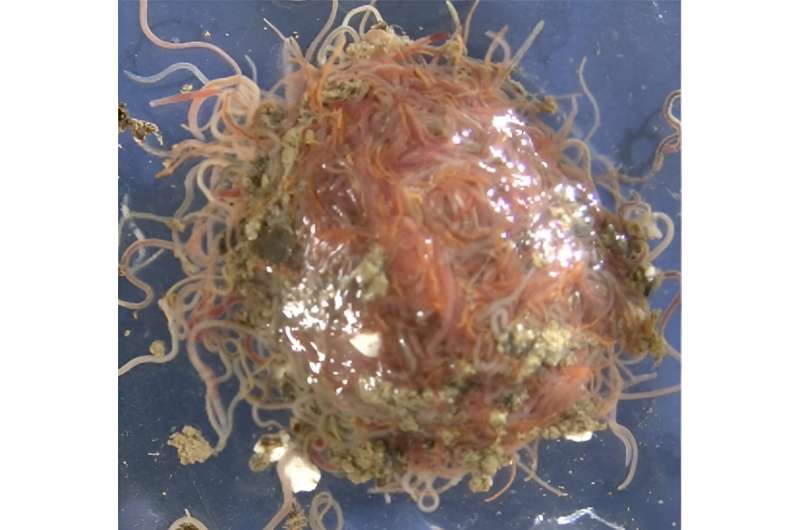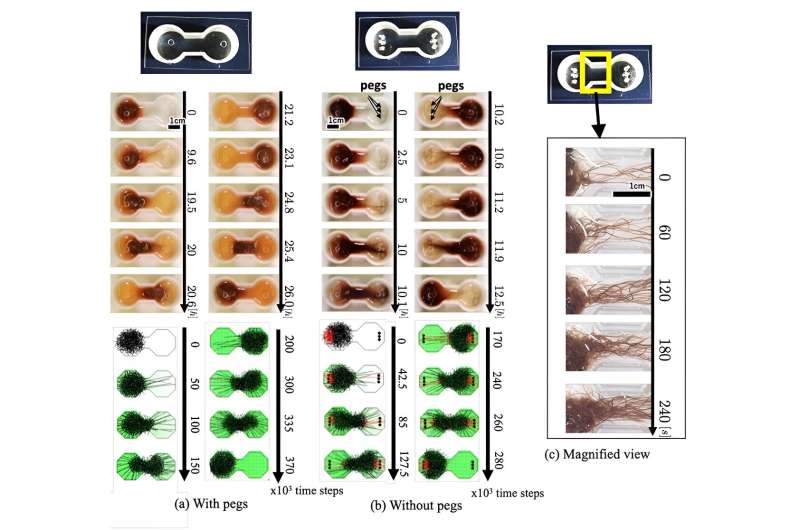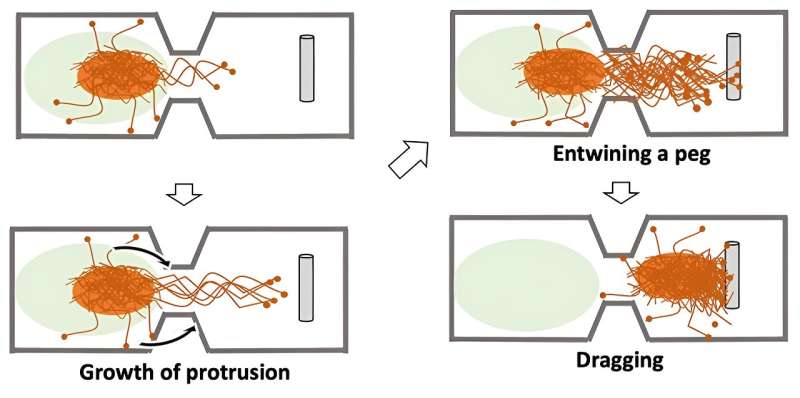This article has been reviewed according to Science X's editorial process and policies. Editors have highlighted the following attributes while ensuring the content's credibility:
fact-checked
trusted source
proofread
Team simulates collective movement of worm blobs for future swarm robotic systems

Tubificine worms are segmented worms that are capable of forming entangled blobs that behave as a single organism to adapt to extreme environmental conditions or migrate more efficiently. Individual worms are capable of elongating, entwining an uneven area of terrain and dragging the collective worm ball through a narrow passageway in laboratory experiments.
A group of scientists from Tohoku University and Hiroshima University recently created an uneven and confined terrain to study the collective movement of worm blobs. The artificial terrain resembled a dumbbell shape with three small posts on each side. The worm blob was confined to one side of the terrain by a narrow passageway that the blob couldn't move through without narrowing its spherical shape.
The researchers successfully simulated the collective movements of the worms and hope to use the design for future swarm robotic systems, or systems of many individual components that must work collectively, using soft-bodied agents. The team published their findings in the August 29 issue of Frontiers in Neurorobotics.
"Previous studies on the locomotion mechanisms of swarms of worm-shaped organisms have focused on locomotion in flat environments, but it was still unclear how they move in real-world environments, which have confined spaces and convex and concave environments, by exploiting interindividual physical interactions," said Takeshi Kano, principal investigator of the study and assistant professor at the Graduate School of Integrated Sciences for Life at Hiroshima University in Higashi-Hiroshima, Japan.

"In contrast, we investigated the mechanism of the adaptive locomotor behavior of worm-shaped organisms in a confined environment," said Kano. "These behavioral experiments in environments with various boundary conditions helped us understand how the worms collectively move in complex environments... by exploiting physical connection-based interactions among the individual worms."
When worms form blobs, the worms on the outer edge of the blob keep their heads in the inside of the blob and their tails facing the outside. Based on preliminary experiments using only a few worms, the research team hypothesized that exposing worm blobs to a chemical repellent would cause some worms from the blob to move away from the repellent by moving their heads out of the blob and extending outwards.
The team further hypothesized that individual worms from the worm blobs would extend their heads from the blob in their confined, dumbbell-shaped terrain and join to form a growing appendage of sorts, or pseudopod, that could entwine with the pegs on the far side of the terrain. The pseudopod would then pull and deform the blob through the narrow terrain passageway while enlarging the pseudopod with more worms.
Subsequent experiments supported the team's hypothesis. "Our results suggest that the worm blobs maintained their hemispherical shape in the open arena. However, in a confined channel with several pegs, the blob could deform flexibly and move effectively using the pegs," said Kano.

Importantly, the team was able to accurately simulate the worm blob behaviors mathematically, providing a means to replicate the individual and collective movements of the worm blobs in artificial systems, such as swarm robotics, that require many individual components to move collectively.
While the formation of the worm blob provides some measure of protection to tubificine worms from negative environmental conditions and predators, maintaining a blob-like structure when moving through tight spaces is impractical, according to the researchers. The primary advantage of their spherical structure is likely the growth of pseudopod structures that allow the worms to explore their environment for features of the terrain they can exploit for movement away from poor environments.
The team expects their worm blob modeling to be used in the design of future swarm robotic systems. Further experiments will need to be conducted, however, to simulate worm blob movements in more complex environments and to create simulations that account for the bending ability of worms.
More information: Taishi Mikami et al, Elongating, entwining, and dragging: mechanism for adaptive locomotion of tubificine worm blobs in a confined environment, Frontiers in Neurorobotics (2023). DOI: 10.3389/fnbot.2023.1207374


















